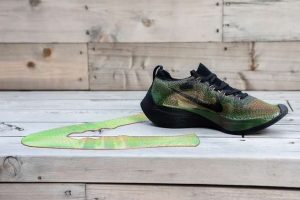Nike has just released its 3D printed new shoe called the Zoom Vaporfly Elite Flyprint sneaker. This shoe can be worn by anyone but it was specifically made for marathon runners because of how light it was and because of its carbon fiber plate in the midsole that increases the amount of spring in a person’s step. Since it is 3D printed with thermoplastic urethane plastic is does not absorb water. This helps marathon runners not have to worry about their shoes absorbing water and making each step heavier when it rains. Not only is the material of this shoe not absorbent of water it is also very flexible and light.
The Flyprint does not allow water absorb in two different ways. First, it’s material, TUP, does not absorb any water since it is plastic. It also does not allow this because it is 3D printed with many holes in it. These thousands of tiny holes allow water to go into the show, but also allows water to be let out so it doesn’t stay trapped inside of the shoe
3D printing plays a huge role in the success of this shoe. It allows Nike to be able to manipulate this shoe in any way that they want to. Through trial and error, they can see what works and what doesn’t and they can print a new one if one fails.
I find this article very interesting since we are working on our final project in IST110 and it has to do with 3D printing. It is amazing the different type of materials that you can 3D print with and how easy is it to 3D print as long as you have the right tools, equiptment, and software. This Zoom Vaporfly Elite Flyprint sneaker can have a huge impact on marathon runners. I hope to see more innovative 3D prints being created for athletics and other people over the next few years.


This article really caught my eye! The popularity of 3D printing is taking over many markets. I would’ve never expected a company like Nike, to make their shoe products using a 3D printer. For our final project we needed to create a model that would be 3D printed and just designing the product was a challenge! Also the model that we 3D printed was just a prototype. It blows my mind that Nike used 3D printing to make the final product of shoes that will be worn! They use this process to their benefit by including materials that will make the shoe much more successful and convenient to consumers. They thought about the small holes, and the materials,etc. and what it would be best for- which is why they specified for marathon runners. It is so interesting seeing all the directions 3D printing is going in. It seems as though everything can be created through 3D printing. I read an article about how you can 3D print glass objects! It makes me wonder what will be next.
https://www.nytimes.com/2017/04/19/science/3d-printer-glass.html
Nike recently released its first pair of 3D-printed tennis shoes, marking an magnificent milestone for not only the company, but the entire the shoe industry. 3D printing a pair of shoes has been just a mere idea for many for several years now, but Nike has finally maybe that idea come to life. Other brands like Adidas have 3D-printed similar models of shoes, which have been released over the past several month. 3D-printers have allowed companies to create prototypes of shoes much more effectively and quickly than traditional processes. 3D-printing allows brands to create several models quickly and release them into the market in record timing. Originally, 3D-printing was only used to design a sneaker’s midsole, which is what Adidas has done in the past. Nike on the other hand, were the first company to 3D-print the entire shoe, midsole and upper textile included. Nike announced on April 17, just a few days ago, the groundbreaking technique they titled Flyprint. The process of creating a 3D-printed textile upper is called solid deposit modeling. Nike explains the process required a thermoplastic filament to melt and lay the layers of the shoes. The technique uses modified 3D-printers which allow the designers customize the textile as needed. The shoes use a lattice of fused material, unlike traditional woven shoes, and can be modified however the designers please. Nike is able to modify each shoe through the machine to supports a runner’s foot and are very comfortable and malleable even though they are 3D-printed in a plastic material. Nike also believes the shoes are lighter and more breathable than any other shoe on the market.
https://quartzy.qz.com/1254503/nike-just-debuted-flyprint-a-3d-printed-stretchy-customizable-sneaker-upper/
It is amazing to see just how far 3D printing can go. What used to be a machine to make tiny toys has now become a major influencer on a lot of products made today. At first many were worries about how a 3D printed shoe would look and feel. Fortunately, Nike’s design for the Vapor is pretty sharp. It is always exciting when big name companies become even more innovative, and 3D printing is the way to go. However, Nike is not the only company to do this.
Back in January of this year, Adidas, Nike’s number one competitor, joined with the company Carbon as they finally released their 3D printed shoe. The Futurecraft 4D is Adidas’ competitive product to the Nike Vapor. “Carbon has become a leading light in the industry-wide push to bring 3D printing to manufacturing.” This partnership is huge for both parties. A lot of success will come out of this, and it will be interesting to see who, either Nike or Adidas, will be on top of the 3D printed shoe game.
https://techcrunch.com/2018/01/18/adidas-joins-carbons-board-as-its-3d-printed-shoes-finally-drop/